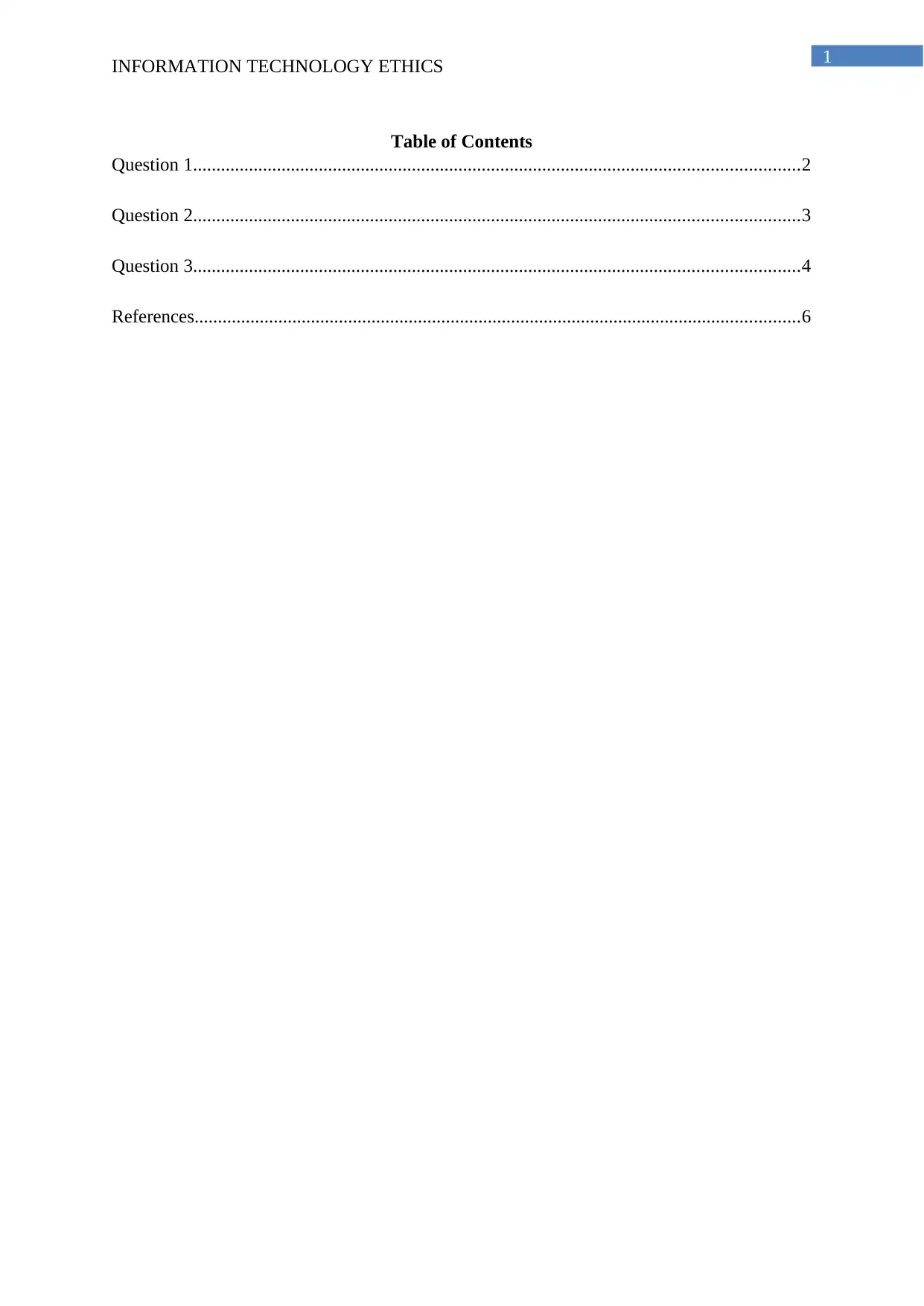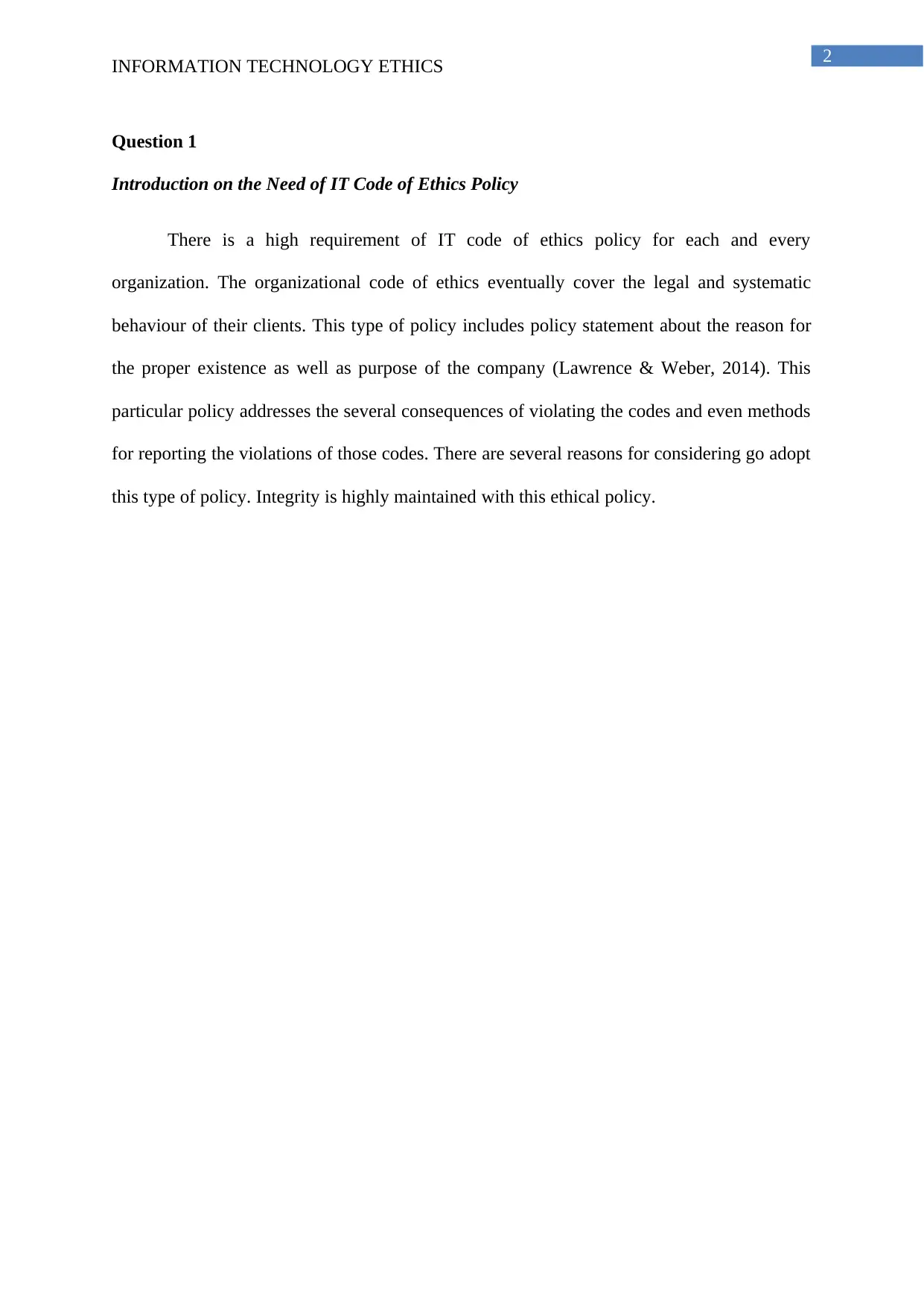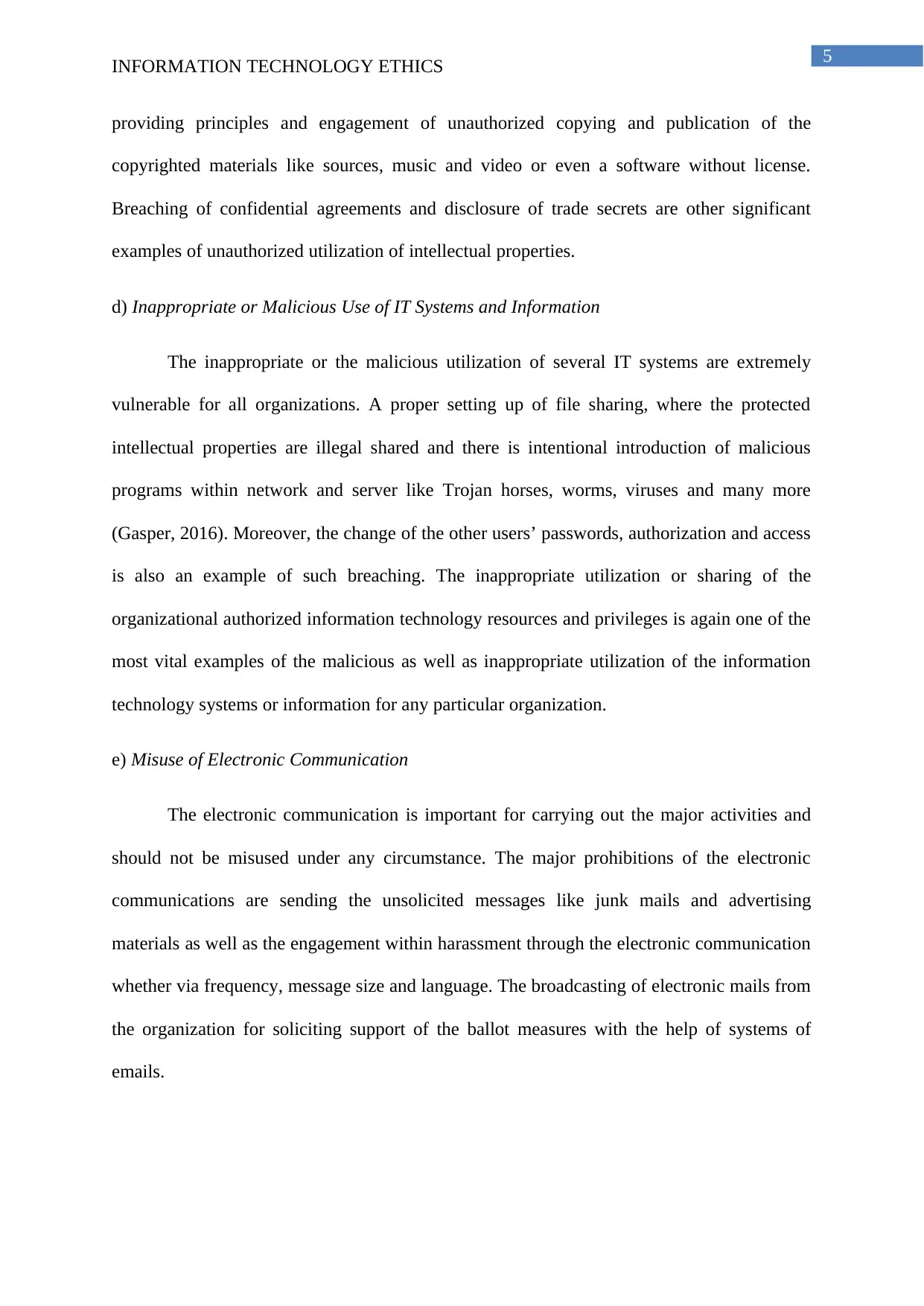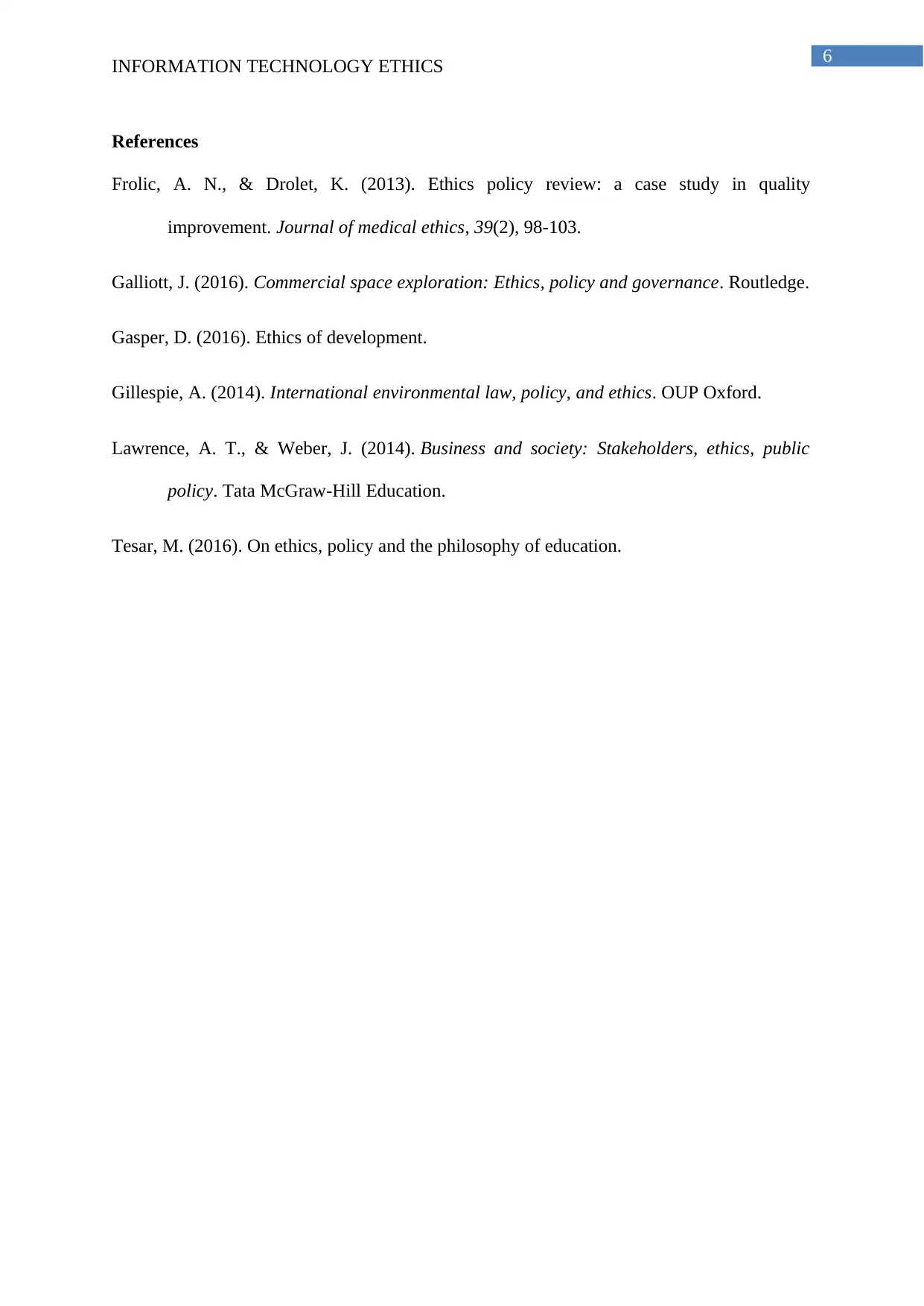IT Ethics: Policy Statement and Unacceptable Use Analysis
VerifiedAdded on 2023/05/29
|7
|1052
|287
Essay
AI Summary
This essay provides a detailed overview of information technology ethics, emphasizing the critical need for an IT code of ethics policy within organizations to ensure legal and systematic behavior. It outlines key principles for such a policy, including maintaining integrity, adhering to the law, acting ethically for stakeholders' benefits, and enhancing the organization's reputation. Furthermore, the essay examines unacceptable use policies, covering excessive non-priority use of computing resources, prohibited system and network activities, unauthorized use of intellectual property, inappropriate or malicious use of IT systems and information, and misuse of electronic communication. The document concludes by underscoring the importance of adhering to these ethical guidelines to safeguard organizational assets and maintain a responsible IT environment. Desklib provides access to this document and many other solved assignments for students.

Running head: INFORMATION TECHNOLOGY ETHICS
Information Technology Ethics
Name of the Student
Name of the University
Author’s Note:
Information Technology Ethics
Name of the Student
Name of the University
Author’s Note:
Paraphrase This Document
Need a fresh take? Get an instant paraphrase of this document with our AI Paraphraser

1
INFORMATION TECHNOLOGY ETHICS
Table of Contents
Question 1..................................................................................................................................2
Question 2..................................................................................................................................3
Question 3..................................................................................................................................4
References..................................................................................................................................6
INFORMATION TECHNOLOGY ETHICS
Table of Contents
Question 1..................................................................................................................................2
Question 2..................................................................................................................................3
Question 3..................................................................................................................................4
References..................................................................................................................................6

2
INFORMATION TECHNOLOGY ETHICS
Question 1
Introduction on the Need of IT Code of Ethics Policy
There is a high requirement of IT code of ethics policy for each and every
organization. The organizational code of ethics eventually cover the legal and systematic
behaviour of their clients. This type of policy includes policy statement about the reason for
the proper existence as well as purpose of the company (Lawrence & Weber, 2014). This
particular policy addresses the several consequences of violating the codes and even methods
for reporting the violations of those codes. There are several reasons for considering go adopt
this type of policy. Integrity is highly maintained with this ethical policy.
INFORMATION TECHNOLOGY ETHICS
Question 1
Introduction on the Need of IT Code of Ethics Policy
There is a high requirement of IT code of ethics policy for each and every
organization. The organizational code of ethics eventually cover the legal and systematic
behaviour of their clients. This type of policy includes policy statement about the reason for
the proper existence as well as purpose of the company (Lawrence & Weber, 2014). This
particular policy addresses the several consequences of violating the codes and even methods
for reporting the violations of those codes. There are several reasons for considering go adopt
this type of policy. Integrity is highly maintained with this ethical policy.
⊘ This is a preview!⊘
Do you want full access?
Subscribe today to unlock all pages.

Trusted by 1+ million students worldwide

3
INFORMATION TECHNOLOGY ETHICS
Question 2
Policy Statement
The IT code of ethics policy provides the set of principles, which support a proper
culture of stronger governance and even the highest ethical conduct after defining the
integrity, behaviour and professionalism of the employees.
The policy statement comprises of few key principles (Frolic & Drolet, 2013). These
principles are as follows:
i) The actions should be governed by the high standards of confidentiality and
integrity.
ii) The organizational decisions should made in accordance to the spirit as well as
letter of law.
iii) The respective business should be conducted ethically and honestly with the best
skills or judgement for the stakeholders’ benefits.
iv) The organizational actions should be for the unambiguous advantage of the
company.
v) The organizational actions must seek for enhancing the reputation as well as
performance of the organization (Tesar, 2016).
The personnel should comply with the code of ethics policy and this should be applied
to every business activity with the stakeholders for operating and conducting the business.
INFORMATION TECHNOLOGY ETHICS
Question 2
Policy Statement
The IT code of ethics policy provides the set of principles, which support a proper
culture of stronger governance and even the highest ethical conduct after defining the
integrity, behaviour and professionalism of the employees.
The policy statement comprises of few key principles (Frolic & Drolet, 2013). These
principles are as follows:
i) The actions should be governed by the high standards of confidentiality and
integrity.
ii) The organizational decisions should made in accordance to the spirit as well as
letter of law.
iii) The respective business should be conducted ethically and honestly with the best
skills or judgement for the stakeholders’ benefits.
iv) The organizational actions should be for the unambiguous advantage of the
company.
v) The organizational actions must seek for enhancing the reputation as well as
performance of the organization (Tesar, 2016).
The personnel should comply with the code of ethics policy and this should be applied
to every business activity with the stakeholders for operating and conducting the business.
Paraphrase This Document
Need a fresh take? Get an instant paraphrase of this document with our AI Paraphraser

4
INFORMATION TECHNOLOGY ETHICS
Question 3
Unacceptable Use Policy
a) Excessive Non-Priority Use of Computing Resources
The priority for the utilization of computing resources should be provided to the
activities related to the organizational vision and mission. The network or computing
resources are restricted in capacity (Galliott, 2016). For conserving the IT resource capacities
for each user, the individual must exercise the restraint while using such resources. The
organizational members should require the non-priority utilization of IT resources.
b) Unacceptable System and Network Activities
The unacceptable as well as network activities majorly involve the proper engagement
within the effecting security breach and malicious utilization of the network communications.
The configuration information is obtained about the system and network for which the users
do not comprise of any administrative responsibility. Moreover, the proper engagement
within the activities that are intended to hide the identity of the users and purposely increment
the network traffic, often create danger for the systems and networks (Gillespie, 2014).
Another effective network activity would be the circumvention of user authentication or
access of data, systems and accounts, which the users are not expressly authorized for
accessing. The interfering and denying of the services to any other user over the campus
network outside the organization.
c) Unauthorized Use of Intellectual Property
The users should not utilize the networks for violating the legal as well as ethical
rights of the organization that is protected by the copyright, patents, other intellectual
properties, trade secrets and other laws and regulations. These types of violations involve
INFORMATION TECHNOLOGY ETHICS
Question 3
Unacceptable Use Policy
a) Excessive Non-Priority Use of Computing Resources
The priority for the utilization of computing resources should be provided to the
activities related to the organizational vision and mission. The network or computing
resources are restricted in capacity (Galliott, 2016). For conserving the IT resource capacities
for each user, the individual must exercise the restraint while using such resources. The
organizational members should require the non-priority utilization of IT resources.
b) Unacceptable System and Network Activities
The unacceptable as well as network activities majorly involve the proper engagement
within the effecting security breach and malicious utilization of the network communications.
The configuration information is obtained about the system and network for which the users
do not comprise of any administrative responsibility. Moreover, the proper engagement
within the activities that are intended to hide the identity of the users and purposely increment
the network traffic, often create danger for the systems and networks (Gillespie, 2014).
Another effective network activity would be the circumvention of user authentication or
access of data, systems and accounts, which the users are not expressly authorized for
accessing. The interfering and denying of the services to any other user over the campus
network outside the organization.
c) Unauthorized Use of Intellectual Property
The users should not utilize the networks for violating the legal as well as ethical
rights of the organization that is protected by the copyright, patents, other intellectual
properties, trade secrets and other laws and regulations. These types of violations involve

5
INFORMATION TECHNOLOGY ETHICS
providing principles and engagement of unauthorized copying and publication of the
copyrighted materials like sources, music and video or even a software without license.
Breaching of confidential agreements and disclosure of trade secrets are other significant
examples of unauthorized utilization of intellectual properties.
d) Inappropriate or Malicious Use of IT Systems and Information
The inappropriate or the malicious utilization of several IT systems are extremely
vulnerable for all organizations. A proper setting up of file sharing, where the protected
intellectual properties are illegal shared and there is intentional introduction of malicious
programs within network and server like Trojan horses, worms, viruses and many more
(Gasper, 2016). Moreover, the change of the other users’ passwords, authorization and access
is also an example of such breaching. The inappropriate utilization or sharing of the
organizational authorized information technology resources and privileges is again one of the
most vital examples of the malicious as well as inappropriate utilization of the information
technology systems or information for any particular organization.
e) Misuse of Electronic Communication
The electronic communication is important for carrying out the major activities and
should not be misused under any circumstance. The major prohibitions of the electronic
communications are sending the unsolicited messages like junk mails and advertising
materials as well as the engagement within harassment through the electronic communication
whether via frequency, message size and language. The broadcasting of electronic mails from
the organization for soliciting support of the ballot measures with the help of systems of
emails.
INFORMATION TECHNOLOGY ETHICS
providing principles and engagement of unauthorized copying and publication of the
copyrighted materials like sources, music and video or even a software without license.
Breaching of confidential agreements and disclosure of trade secrets are other significant
examples of unauthorized utilization of intellectual properties.
d) Inappropriate or Malicious Use of IT Systems and Information
The inappropriate or the malicious utilization of several IT systems are extremely
vulnerable for all organizations. A proper setting up of file sharing, where the protected
intellectual properties are illegal shared and there is intentional introduction of malicious
programs within network and server like Trojan horses, worms, viruses and many more
(Gasper, 2016). Moreover, the change of the other users’ passwords, authorization and access
is also an example of such breaching. The inappropriate utilization or sharing of the
organizational authorized information technology resources and privileges is again one of the
most vital examples of the malicious as well as inappropriate utilization of the information
technology systems or information for any particular organization.
e) Misuse of Electronic Communication
The electronic communication is important for carrying out the major activities and
should not be misused under any circumstance. The major prohibitions of the electronic
communications are sending the unsolicited messages like junk mails and advertising
materials as well as the engagement within harassment through the electronic communication
whether via frequency, message size and language. The broadcasting of electronic mails from
the organization for soliciting support of the ballot measures with the help of systems of
emails.
⊘ This is a preview!⊘
Do you want full access?
Subscribe today to unlock all pages.

Trusted by 1+ million students worldwide

6
INFORMATION TECHNOLOGY ETHICS
References
Frolic, A. N., & Drolet, K. (2013). Ethics policy review: a case study in quality
improvement. Journal of medical ethics, 39(2), 98-103.
Galliott, J. (2016). Commercial space exploration: Ethics, policy and governance. Routledge.
Gasper, D. (2016). Ethics of development.
Gillespie, A. (2014). International environmental law, policy, and ethics. OUP Oxford.
Lawrence, A. T., & Weber, J. (2014). Business and society: Stakeholders, ethics, public
policy. Tata McGraw-Hill Education.
Tesar, M. (2016). On ethics, policy and the philosophy of education.
INFORMATION TECHNOLOGY ETHICS
References
Frolic, A. N., & Drolet, K. (2013). Ethics policy review: a case study in quality
improvement. Journal of medical ethics, 39(2), 98-103.
Galliott, J. (2016). Commercial space exploration: Ethics, policy and governance. Routledge.
Gasper, D. (2016). Ethics of development.
Gillespie, A. (2014). International environmental law, policy, and ethics. OUP Oxford.
Lawrence, A. T., & Weber, J. (2014). Business and society: Stakeholders, ethics, public
policy. Tata McGraw-Hill Education.
Tesar, M. (2016). On ethics, policy and the philosophy of education.
1 out of 7
Related Documents
Your All-in-One AI-Powered Toolkit for Academic Success.
+13062052269
info@desklib.com
Available 24*7 on WhatsApp / Email
![[object Object]](/_next/static/media/star-bottom.7253800d.svg)
Unlock your academic potential
Copyright © 2020–2025 A2Z Services. All Rights Reserved. Developed and managed by ZUCOL.




